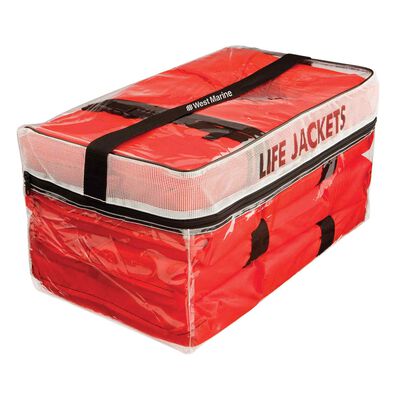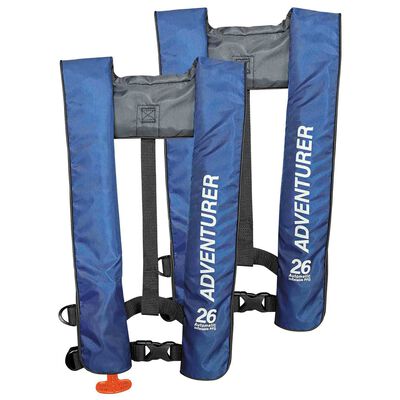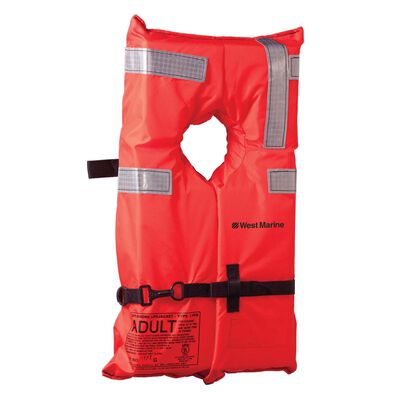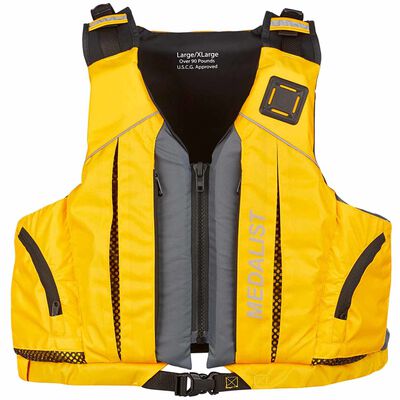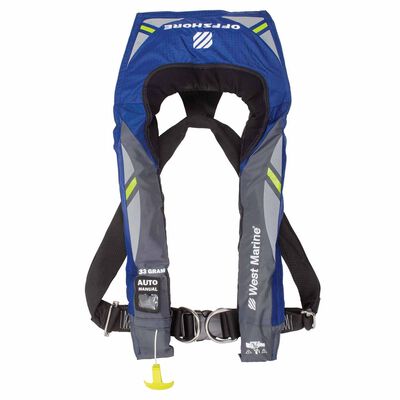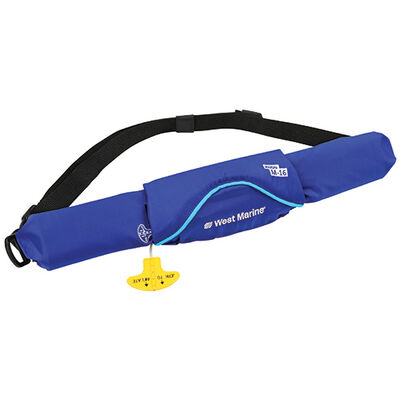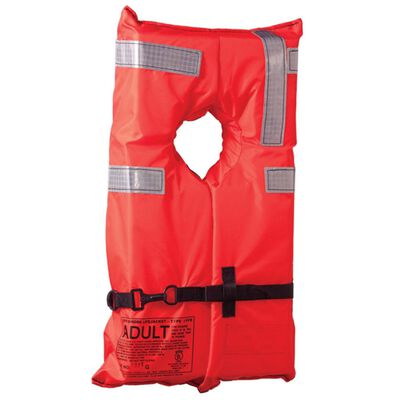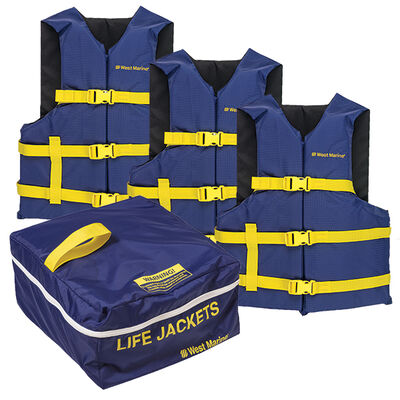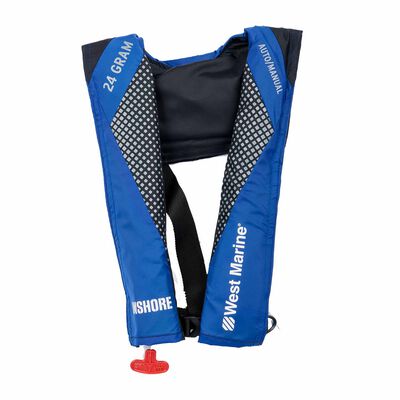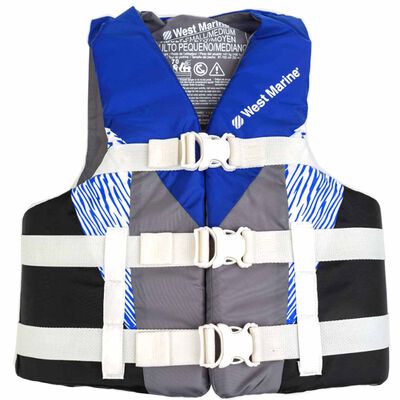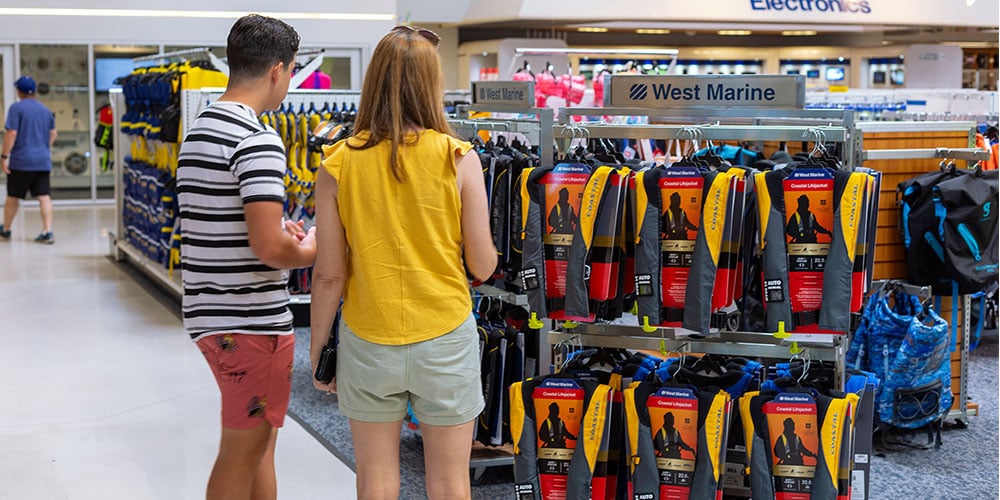
We carry life jackets in a variety of designs to meet the requirements of a wide variety of boating activities. In the video below, Chuck Hawley, West Marine alumnus (and recognized expert on boating safety) presents examples and discusses the features and benefits of different life jacket designs. Chuck also discusses USCG Type approvals and gives examples for each. Editor's Note: In October of 2014, the United States Coast Guard removed references to “Type codes” from regulations on the carriage and labeling of Coast Guard-approved personal flotation devices. As of June 2020, this change affects labeling for USCG Type III flotation devices only. See "Legacy Type III Personal Flotation and Equivalent Level 70 Labeling" below.
- Who Needs a Life Jacket?
- USCG Standards
- Classifying Inflatable PFDS by Coast Guard Types
- More About Type V PFDs
- What Type of PFD Do I Need?
- Other Features to Consider
Who Needs a Life Jacket?
The USCG requires all passengers on a boat or other qualifying vessel to have a USCG-approved personal flotation device whenever onboard. This means your boat must have at least as many USCG approved life jackets as there are people onboard. In most states, children under the age of 13 are required to wear a life vest at all times when on a boat.
There are some watercraft that fall in a bit of a gray area. For example, according to the USCG, a stand-up paddleboard (SUP) is legally considered a "vessel," and must abide by the laws regarding vessels "when used beyond the narrow limits of a swimming, surfing or bathing area". On the East, West and Gulf Coasts of the United States, this means that SUPs used outside of the surf zone are required to carry a personal flotation device, a whistle (or other sound-producing device) and—if out after dark—a white light to give warning to other vessels in the area. What about inland waters outside of Federal jurisdiction? State boating laws vary, so "know before you go", and check your local regulations.
USCG Standards
Personal Flotation Devices (PFDs) are available in inherently buoyant (foam) and inflatable designs. All of them can be sorted into USCG Types which are based pricipally on performance designations.
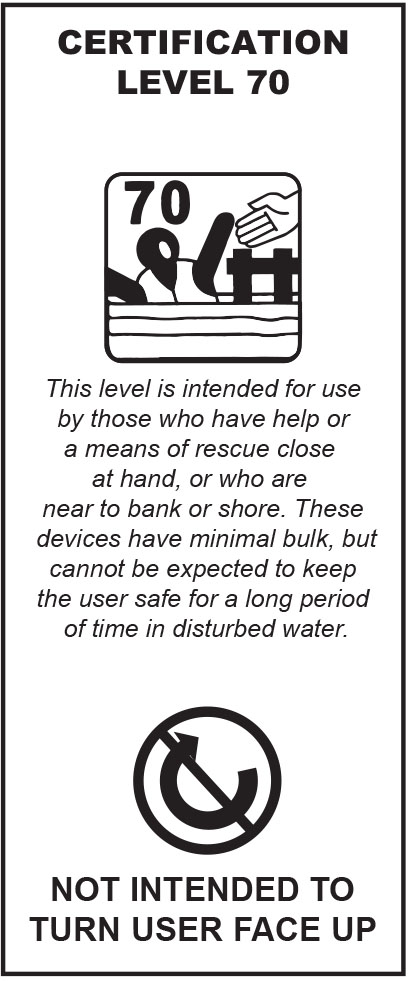
Labeling for Type III foam life vests is switching to icons that indicate Level 70 performance. (Not to scale.)
- Type I: These are mandatory for commercial vessels. They are large, bulky and fairly uncomfortable for recreational use. They have 22 pounds of buoyancy and keep the wearer high in the water.
- Type II: Carrying a few Type II life jackets on board is an inexpensive option to keep you "Coast Guard legal" in the event of unexpected guests. These are the standard, boxy, single-strap, orange life jackets. They offer of 15 1/2 of pounds of buoyancy and are designed to turn an unconcious victim face up. However, because they are bulky and not comfortable, we do not recommend them for personal, extended use. Instead, we suggest that the best life jacket for you is the one you will actually want to wear—which is why we recommend that you select inherently buoyant (foam) Type III/Level 70 life jackets or inflatable PFDs.
- Legacy Type III and Equivalent Level 70: These life jackets provide 15 1/2 pounds of buoyancy (less for children and youth models) and are available in a large number of styles for different types of on-the-water activities. Wakeboarders, kayakers, sailors and many other boaters can all find a Type III life vest designed for their style of boating. Editors note: Labeling for Type III PFDs is gradually being replaced with icon-based labels that denote "Level 70 performance". For more about this change, see Harmonized Life Jacket Approvals, kindly supplied to West Marine by the Kent Sporting Goods Company.
- Type IV: All boats 16' and longer (except sailboards, racing shells, rowing sculls, racing canoes and racing kayaks) must also carry one of these throwable PFDs.
- Type V: This Type designates a special use device or a device that requires special care or knowledge of its specific features. It is a catchall for PFDs that don't fit in the other categories but are still approved by the USCG. For example, automatic inflatable life jackets with a built-in harness are assigned to this category. In order to provide specific information about what each Type V PFD is useful for, they will often be listed as Type V with Type I, II or III Performance. We will discuss Type Performance below when covering Inflatable PFDs. Any PFD you keep on your boat to satisfy the one PFD per person rule must be USCG approved, in serviceable condition and sized to the wearer.
Classifying Inflatable PFDs by Coast Guard Types
Prior to Coast Guard-approved inflatables, you could determine a PFD’s USCG type by sight. Type IIIs looked like vests or float coats, Type IVs were horseshoes, rings, or cushions, and so forth. The introduction of inflatable PFDs changed everything. Inflatables are given a Coast Guard type, just like non-inflatables, but they are also given a performance type and a designation as to whether they have to be worn to be counted in the vessel’s life jacket inventory. What this means is that you cannot simply say that an inflatable is a Type III and equate its characteristics to the Type III with which you are familiar. All inflatables are for swimmers 16 years or older and all Type II and III inflatables provide some degree of turning ability and greater buoyancy than comparable Type II or Type III foam vests. Here are some pointers on how inflatables are classified:
- Inflatables with harnesses are, by default, Type V life jackets. They come with instructions that you should be familiar with when wearing a harness. Their performance type is generally Type III or Type II.
- Belt pack inflatables are Type V life jackets with Type III performance. They are for competent swimmers only, because they require secondary donning of the life jacket in the water after inflating it and some require additional topping off of the bladder using the oral inflation tube.
- High buoyancy inflatables (150 N or 33 pounds of buoyancy) have a Type III performance rating if they are manually-activated with a ripcord, and a Type II performance rating if they are water-activated. Since the bladder and the rest of the life jacket are identical except for the inflator, once they’re inflated they perform exactly the same.
- The Coast Guard requires that automatic, water-activated inflatables that lack a single-point, arming status indicators that are readily visible have to be worn to be counted in the vessel’s inventory of life jackets. Inflatable life jacket models that do include a ready-status indicator (so-called "stowables") don’t have to be worn to be counted as inventory. However, this misses the point of inflatable PFDs, which are so comfortable that you’ll wear them while on the water.
- Inshore Coastal Series inflatables use a 24g cylinder, and provide 26 pounds of flotation. They are only legal when worn.
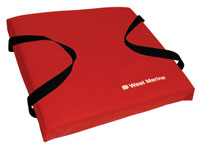
Type IV Throwable Device. Not to be worn.
More About Type V PFDs
This category is comprised of inflatable PFDs that have special features or require user interaction for use. PFD Belt Packs are one example. These PFDs are worn deflated on one's waist. Once inflated they must be manually slipped over one's head, which makes PFD belt packs appropriate for competent swimmers only. Inflatable PFDs with a built-in harness (to which you attach a tether) are another example of a Type V PFD.
- Inflatable PFDs with harnesses are always Type V. Along with the the benefit of a built-in harness, when inflated these devices provide the buoyancy of an offshore SOLAS-grade PFD or Type I foam life vest.
- As mentioned, belt packs are Type V. Base your selection on the desired level of performance and and keep in mind that belt packs are not sufficient if you are at risk of going overboard unconscious. This is because you will have to manually activate the inflator and then slip the inflated chamber over your head.
- High-buoyancy inflatables with 33 pounds of buoyancy have a Type III performance rating if they are manually activated with a ripcord, and Type II if they are water activated. This seems counterintuitive, as they perform the same once inflated, but it has more to do with the method of inflation and whether or not the wearer has to be conscious to use it.
- Some inflatables are only legal when worn. This is important to know when purchasing PFDs for your boat. While standard PFDs will always float in the case of an emergency, some inflatables will not unless activated. If you want to stow inflatables, review the approval label.
Many boaters keep spare PFDs stowed for guests to keep with USCG regulations, but if you are stowing extra PFDs, we recommend inherently buoyant (foam) models. If you have enough inflatable PFDs onboard, have each boater actually wear theirs. They are generally so comfortable you will forget you are wearing them, unlike standard PFDs.
What Type of PFD do I Need?
This depends largely on what kind of boating you enjoy. Below are a list of common water-based activities and the PFDs we recommend for each.
Recreational
Powerboats and sailboats in relatively calm, warm water should be stocked with PFDs that provide comfort and freedom of movement. We recommend a belted or day sailing vest, or an inshore inflatable that falls under Type III. This category includes many options in terms of style, fit and deployment. A Type II PFD could work for recreational boaters, but keep in mind that these are bulkier and restrict movement. If you plan on spending many long days on the water, go for the more comfortable option that won't chafe.
Water Sports
Activities like wakeboarding, water skiing, being towed on an inflatable tube and riding a personal watercraft present a risk of repeated water entry at high speed. PFDs for watersports must remain intact and securely attached to your body. Belted vests with three or four strong belts encircling your torso work best because they won’t get torn off easily, even when you wipe out at high speed. Look for vests that have "watersports" marked on the label, and ensure that they can be adjusted to a snug fit. (Editor's note: The USCG does not allow lifejackets to be advertised as providing protection from impact and they cannot reference impact on the labels or in marketing.)
Day Sailing
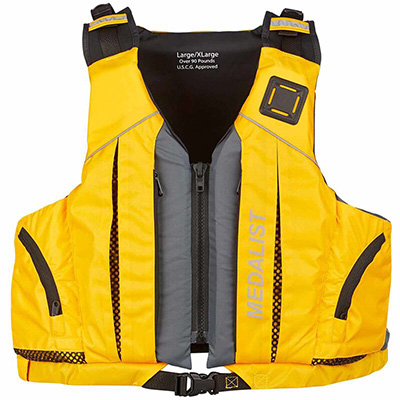
Our type III Medalist Day Sailing Life Jacket for adults offers a minimum of 15 1/2 pounds of buoyancy. Life jacket buoyancy can be used to right this El Toro in the event of a capsize.
Sailing small boats requires PFDs that fit snug to the body and that maximize freedom of movement. The preferred style has a zippered closure and is made from soft, pliable foam. Day sailing vests often feature an articulating design, with strips of foam inserted into channels that enables the vest to flex and wrap comfortably around your torso. Large armholes offer additional freedom of movement, but may allow the vest to ride up when in the water, so a snug fit is important. If you sail a dinghy or beach catamaran, your PFD may have to be worn with a trapeze harness, so take the harness with you when you shop for a new life jacket. Day Sailing vests are a good choice for a variety of boating styles except for high-speed water sports.
Fishing
Fishing vests include built-in pockets to accommodate anglers who often carry a collection of lures, leaders and other gear. Anglers with high-speed bass boats require vests designed to survive high-speed impacts. Therefore, we offer two distinct types of fishing vests: those with pockets that can hold lure boxes, snacks or fishing tools, and those with wide encircling belts. The second style is similar to watersports PFDs and can be adjusted to a snug and secure fit, so the vest will stay in position during high-speed water entry.
Offshore Sail
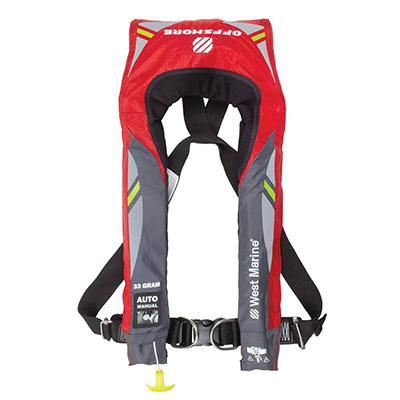
Our All Clear® Offshore Inflatable PFD features automatic or manual inflation and includes a harness for clipping into jacklines.
Offshore vests provide lots of buoyancy, freedom of movement and typically a safety harness that the wearer tethers onto jacklines to stay connected to the boat. In the past, offshore sailors chose between a life jacket and a safety harness, since the two items were seen as interfering with one another. Today’s inflatable life jackets with integrated harnesses provide a high level of safety in one single product. Offshore PFDs equipped with Hammar hydrostatic or Halkey Roberts V95000 inflators require complete submersion before inflation will occur. Neither will inflate due to spray, rain or humidity. West Marine Offshore Series vests only inflate when submerged. Manual and automatic inflation options are available. Virtually all models in the Offshore Sailing category will have similar 35 pounds of buoyancy and a harness that complies with International Sailing Federation (ISAF) standards.
We recommend that offshore powerboaters also have one or two of these vests aboard. You never know when you might need to venture out onto a pitching, slippery deck in rough conditions—perhaps to get the anchor ready or to secure a dinghy that has come loose.
Offshore Power
Passagemaking requires high-buoyancy life jackets designed for rough waters. While the chances of ending up overboard are far lower on a trawler with an enclosed pilothouse, the crew should always wear high-buoyancy inflatable PFDs every time they go on deck. If a crewmember goes overboard the time to rescue may be long, the water may be cold and the sea rough.
Paddlesports
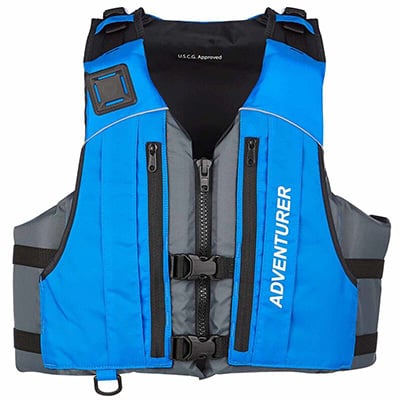
Paddlesports PFDs like our Paddle Adventurer jacket have large arm holes for increased range of motion and often have additonal pockets and D-rings for carrying extra gear.
Canoeists, kayakers and whitewater rafters need PFDs that combine freedom of movement and protection. Many specialized paddlesports PFDs have been developed for niche markets and different styles of paddling, so make sure you try different models that are labeled for paddle sports. Most feature large arm holes for freedom of movement and to reduce chafe when paddling. Kayakers may need vests with high-cut waists that don’t interfere with a spray skirt. Waist-worn inflatable vest belt packs are popular among stand-up paddle boarders. This option, while allowing 100% freedom of movement, is for competent swimmers only, because it requires the user to don the vest manually while in the water.
Commercial Vessels
Commercial vessels must have specific types of life jackets onboard to be legal. We offer a range of Type I life jackets and SOLAS-approved models, often referred to as industrial life jackets, but we don’t recommend their use on recreational boats. Type I devices, due to their bulk, are not practical for recreational boating activities and require extra space to stow. However, if you operate a commercial fishing boat that is required to have Type I vests onboard, West Marine has you covered.
Other Features to Consider
Below are some other attributes or applications for life jackets that affect their performance requirements.
Hypothermia Protection
If you boat in cold climates you should understand the importance of hypothermia protection. Immersion in cold water rapidly reduces your core body temperature, leading to greatly impaired physical and mental capabilities. Even a five-minute immersion in 50°F water can impair your ability to climb a ladder, catch a line, or tread water. In addition to protective clothing such as exposure coveralls, immersion suits, wetsuits, and float coats, a properly fitted Type III vest also can delay the onset and lessen the effects of hypothermia. High buoyancy vests like offshore inflatables allow the wearer to assume the Heat Escape Lessening Posture (HELP), which can double survival times by reducing heat loss to the water.
Maximum Freeboard
Crew who have gone overboard may become unconscious, either through injury or due to hypothermia. In this case, high-buoyancy inflatable or Type I vests are the best choice. These vests are designed to right an unconcious victim face-up in the water and with their extra buoyancy increase the victim's freeboard, which is the distance from the water's surface to their mouth.
Children
Infants and small children are hard to keep floating in a face-up position, and sometimes protest when wearing a PFD. Frankly, we think that boating with infants is not a very good idea if there is any likelihood of the baby ending up in the water. As kids get older and more water-savvy they become right at home onboard. There are many choices for well-fitting PFDs that provide stability and buoyancy.
Those of us who have had to pull our children out of the water appreciate behind-the-head flotation collars designed for smaller kids. These come standard with a grab strap and crotch straps. We highly recommend testing the life jacket you select for your child ahead of time in a safe environment, like a pool, to familiarize yourself and your child with the device's characteristics. Be sure to review the "Important information about children’s PFDs" card that is supplied with these devices.
Be Safe on the Water
- Always have the federally required safety equipment on board, meaning Coast Guard-approved life jackets. If you select non-approved devices, make sure you back them up with what the law requires.
- If you have an older, non-approved SOSpenders, Crewfit, or West Marine inflatable, wear it confidently until its useful life is over (around 10 years). If you have life jackets in your inventory that must be worn to be counted, back them up with Coast Guard approved life jackets so you are never caught short and suffer an expensive fine.
- Establish rules on board your boat defining when life jackets are to be worn and lead by example. Most states require that children always wear a life jacket. Where no state law exists, federal law requires children 13 years and younger to always wear one. Perhaps the same law should apply to parents—since there would be far fewer boating deaths if they always wear one.
